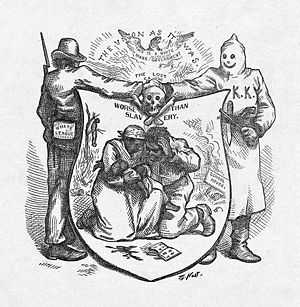White League

The White League was an American white paramilitary group started in 1874 to turn Republicans out of office and intimidate freedmen from voting and political organizing. Its first chapter in Grant Parish, Louisiana was made up of many of the Confederate veterans who had participated in the Colfax massacre in April 1873. Chapters were soon founded in other areas of the state and in New Orleans. During the later years of Reconstruction, it was one of the paramilitary groups described as "the military arm of the Democratic Party."[1] Through violence and intimidation, its members reduced Republican voting and contributed to the Democrats' taking over control of the Louisiana Legislature in 1876.[1]
After white Democrats regained control of the state legislature in 1876, members of the White Leagues were absorbed into the state militias and the National Guard.[2]
History
Although sometimes linked to the secret vigilante groups of the Ku Klux Klan as well as Knights of the White Camelia, the White League and other paramilitary groups of the later 1870s marked a significant difference. They operated openly, solicited coverage from newspapers, and the men's identities were generally known. Similar groups were the Red Shirts, started in Mississippi in 1875 and active also in North and South Carolina. They had specific political goals to overthrow the Reconstruction government. They directed their activities toward intimidation and removal of Northern and black Republican candidates and officeholders. Made up of well-armed Confederate veterans, they worked to turn Republicans out of office, disrupt their political organizing, and use force to intimidate and terrorize freedmen to keep them from the polls. Backers helped finance purchases of up-to-date arms: Winchester rifles, Colt revolvers and Prussian needle guns.[3]
Some sources charge the White League with culpability for the Colfax Massacre of 1873, but the organization was not established under that name until March 1874. Christopher Columbus Nash, a Confederate veteran, former prisoner of war at Johnson's Island in Ohio, and the former sheriff of Grant Parish, led companies of white militias at Colfax, the seat of Grant Parish, and killed tens of blacks in the Colfax Massacre.
The first unit of the White League, founded in 1874, was composed of members of Nash's force, mostly Confederate veterans who had participated in the Colfax Massacre.[4] It expressed its purpose as defenders of a "hereditary civilization and Christianity menaced by a stupid Africanization."[5]
In the Coushatta Massacre, another Red River parish, the local White League forced six Republican officeholders to resign and promise to leave the state. The League assassinated the men before they left the parish, together with between five and twenty freedmen (sources differ) who were witnesses. Generally in remote areas, the White League's show of force and outright murders always overcame opposition. They were Confederate veterans, experienced and well armed.[6]
Later in 1874, the Metropolitan Police of New Orleans, established as a state militia by the Republican governor, attempted to intercept a shipment of arms to the League. The League had entered the city to attempt a takeover of state government. In the subsequent Battle of Liberty Place on September 14, 1874, 5,000 members of the White League routed 3,500 police and state militia to turn out the Republican governor, following the disputed election of 1872. They demanded the resignation of Governor William Pitt Kellogg in favor of John McEnery, the Democratic candidate. Kellogg refused and the White League briefly fought a battle resulting in 100 casualties. They took over and controlled the State House, City Hall and arsenal for three days, withdrawing ahead of Federal troops and ships' arriving to reinforce the government. Kellogg had requested aid from President Grant; once the troops arrived, he was restored to office.[7]
Grant sent additional troops within a month in another effort to try to pacify the Red River valley in northern Louisiana. It had been plagued by violence, including the massacres at Colfax in 1873 and Coushatta in 1874.[8]
See also
- History of New Orleans
- Redemption (United States history)
- Coushatta Massacre
Citations
- ↑ 1.0 1.1 George C. Rable, But There Was No Peace: The Role of Violence in the Politics of Reconstruction, Athens: University of Georgia Press, 1984, p. 132
- ↑ James K. Hogue, "The 1873 Battle of Colfax: Para-militarism and Counterrevolution in Louisiana," Jun 2006, p. 21
- ↑ Nicholas Lemann, Redemption: The Last Battle of the Civil War, New York: Farrar, Straus & Giroux, 2007, pp.70-76
- ↑ James K. Hogue,"The Battle of Colfax: Paramilitarism and Counterrevolution in Louisiana", Jun 2006, p. 21
- ↑ Adolph Reed, Jr., "The battle of Liberty Monument - New Orleans, Louisiana white supremacist statue", The Progressive, June 1993, accessed 18 May 2010
- ↑ Hogue (2006), "The Battle of Colfax", pp. 21-22
- ↑ Nicholas Lemann, Redemption: The Last Battle of the Civil War, New York, Farrar, Straus & Giroux, 2006, p.77.
- ↑ Nicholas Lemann, Redemption: The Last Battle of the Civil War, New York, Farrar, Straus & Giroux, 2006, p.77.
References
- Wall, Bennett H. et al. (2002). Louisiana: A History. pp. 208–210. ISBN 0-88295-964-6.